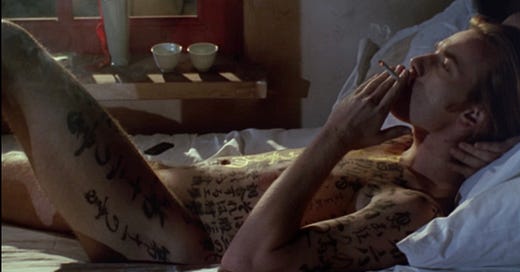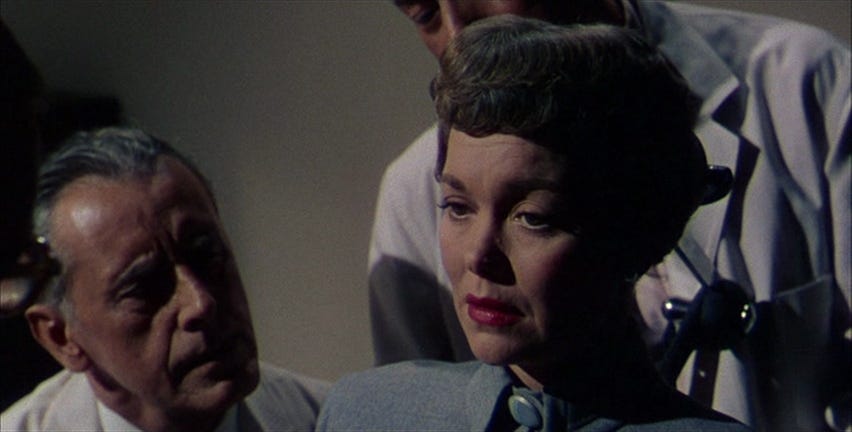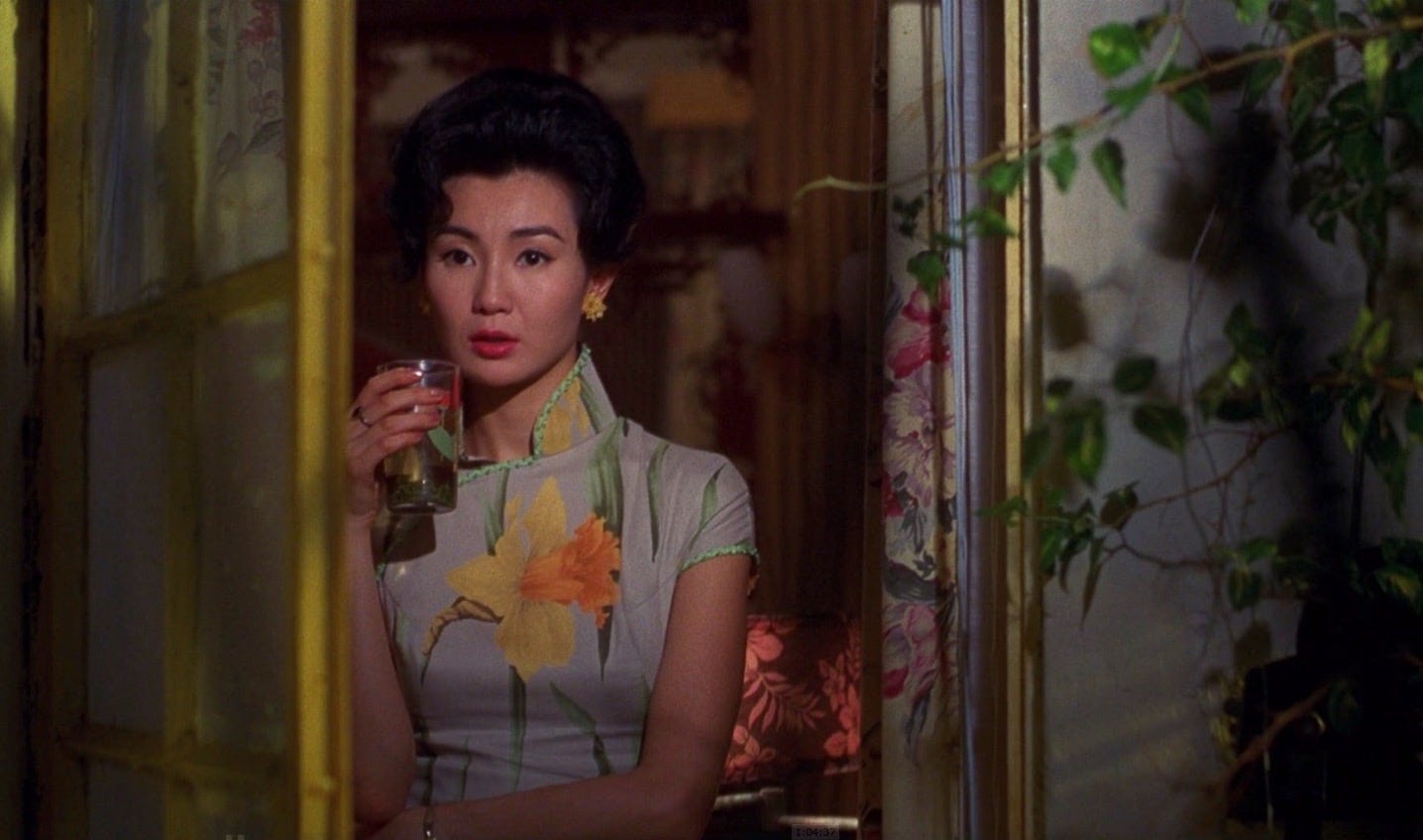From the Vault: July '21 Streaming
"Be Gay Do Crimes"; Ewan McGregor, Ranked!; the Melodrama; Costume Design; and "Porno Chic"
July 1, 2021
Welcome to July, everyone!
As I will be passively observing my 30th birthday this month, and as it's my day, I'm celebrating with a month of my most personal and favorite themes, which I've been saving for a moment like this. And y'all are getting just that! I apologize in advance. This month, we're: considering our own participation in systems of division and in the imposition of laws that make transgression, at times, a necessity; celebrating weeping and fucking; taking in some iconic film costuming, and reviewing an extremely unsurprising actor's showcase that's been a year in the making. On y marche!
A Deep Beauty, a Sunken Beauty, or "Be Gay, Do Crimes"
When one's existence has been criminalized at worst and made marginal at best, there is liberation on the fringe of society and a rejection of hostile assimilation that demands compliance. There is liberation in crime, and by extension, liberation in art. Some of our most enduring queer artists have consecrated this in their works, influencing generations of filmmakers and visual artists. When I say "be gay do crimes," I mean recognizing the two years Oscar Wilde spent incarcerated for the crime of loving other men and the hard prison labor that killed him at 46. Recognizing that Compton Cafeteria and Stonewall were riots, in response to police brutality and systems that manage and uphold oppression in the name of a "law and order." Recognizing the individuals who lost their livelihoods because of Lavender Laws in America, and for those who lost their lives under anti-sodomy statutes in Paragraph 175 of the German criminal code, implemented long before the Nazis and in place long after their removal. Recognizing the timeless allure of the works of gay scribe Jean Genet, who once wrote, "I recognize in thieves, traitors and murderers, in the ruthless and the cunning, a deep beauty - a sunken beauty." This program concerns itself with that beauty. And a surprising amount of lesbian vampires.
He's Got a Huge Talent: Ewan McGregor, Ranked!
At some point in the last year I found myself accidentally on a journey (the most revealing kind of Hero's Journey), finding myself somewhat alarmingly...and one might say pathologically...watching nearly every feature film starring Scottish actor Ewan McGregor, whose career includes "at least 70 films." When picking who to feature for my birthday month, there seemed only one obvious choice: Vince assured me it was time to "share my knowledge with the world." That presented its own problem, which is that I don't quite know how to articulate the significance the Golden Globe and MTV Movie Award winning actor/"director" has played in my own life, or what it was about this actor that I glommed on so strongly to during this difficult past year ("I was horny," feels woefully insufficient). Maybe it really is as simple as Why do you go to movies? To see unhot people? We got to movies who are better looking than we are. But you're just here to understand the filmography of Ewan McGregor, so I'll attempt to break it down: With lethal charm and a fascinating body of work that's often undervalued in the wake of the actor's annoying penchant for franchise parts and corporate shilling, this singular leading man's considerable career spans nearly every genre of film, including the elusive musical. His screen presence may evoke the sophisticated allure of classic British leading men like David Niven and James Mason, but his singing and dancing skills differentiate him from UK contemporaries like Jude Law, Clive Owen, and Colin Farrell, placing him in a rarer echelon of screen idols from a bygone era. Writing on the actor's work in Moulin Rouge! and the film's remarkable appeal to young women, I found myself reflecting on Rudolph Valentino (that doomed silent screen star, whose untimely death allegedly caused suicides, from, as Roland Barthes put it: "that moment in cinema when capturing the human face still plunged audiences into the deepest ecstasy, when one literally lost oneself in a human image as one would in a philtre, when the face represented a kind of absolute state of the flesh, which could be neither reached nor renounced"....). I thought about my own ecstatic response and the history of female moviegoing and moral panic, as well as the state of sexual desire in contemporary film (spoiler: everyone's beautiful and no one's horny). Perhaps situating my own devotion to the actor in terms of cinema history and theory helped me feel a little less insane? Anyway, here's Wonderwall. Although I consider the ranking (which takes into account the quality of product as well as the quality of Ewan's performance therein) pretty extensive, there are limits, even for me, so if you want to hear my thoughts on Nanny McPhee and the Big Bang, you'll need to pay me.
The "Women's Picture," the "Weepie," and the "Soap Opera": The Subversive Power of Melodrama in Film
In her seminal text "Film Bodies: Gender, Genre, and Excess," film scholar Linda Williams cites melodrama as one of three "disreputable" film genres, all aligned with the body -- the other two being porn and horror, corresponding to three bodily responses that are almost involuntary by the viewer: crying, orgasming, or screaming, respectively. As a Cancer, I'm a big fan of all three, but who doesn't love weeping especially? Melodrama is about excess, artifice; a "tear jerker," a "woman's picture," Camp, masochism, subversion, ecstasy. It's a chaos agent, disrupting the heternormative nuclear family and sometimes obliterating happiness. It's referential and malleable, intersecting with other genres like horror, noir, screwball, and romance. Melodrama is a critical function: it questions and interrogates more than it upholds, even if rigid social structures are upheld by the end of a film's story. It's an international tool, favored by queer and subversive filmmakers worldwide, though I'm partial to the American filmmakers (like Douglas Sirk, Nicholas Ray, Leo McCarey, Vincent Minnelli, and Otto Preminger) who use it to peel back the veneer of prosperity and equality that's paper maiched over the terminal rot of this nation and its inherent contempt for the Other.
Costume Design on Film
One of my absolute favorite technical aspects of film production has long been costume design, which while celebrated is often misunderstood and conflated with "fashion." Though there's a considerable intersection between fashion and costume design over the course of cinema history, costume design is a process that cannot be defined or contained by notions of "fashion" or "style," even as it's used so frequently to codify star power. Costume design is the communication of story through clothing worn by screen characters, which is as vital to the development of the mise en scene as any other aspect of the film's production. Costume design takes into account individual characterization (and all the signifiers associated with that individual's place in the world), film style, mood, genre, and vision. It's a highly technical process -- defined by continuity and an understanding of both fit and the appearance and motion of fabrics on screen -- and one that can seem daunting and dense, which is why it's not really studied as much through a theoretical lens the way other aspects of film style, particularly by laymen. I took this great Costume Design course in college (here's the syllabus, for anyone interested), where all we did was discuss costume design through a theoretical lens. Even though costume design is often difficult to talk about (as I am not a seamstress or textiles scholar by any means), I really just wanted to dig my heels in and do it again, so here we are. I've selected a handful of films with my favorite costume design and provided a bit more information about the process, as well as information on the designer and their other works. I also selected a costume from each film that I think is either definitive of the film's costuming (or the most interesting look to discuss).
Mike Nichols told me I just had to see it: "Porno Chic," or, when Porn went Mainstream
We'll, I've done 2/3 of those "disreputable" film genres Linda Williams mentioned, did you really think I'd stop there? In June, Mo and I were lucky enough to attend a screening of Good Hot Stuff, a 1975 documentary made by Manhattan-based gay porn studio Hand in Hand, presented by queer film historian and archivist Elizabeth Purchell, whose wonderful Instgram and Podcast Ask Any Buddy lovingly documents queer erotica. The event coincided with my personal research for this program on the "Golden Age of Porn," dubbed "Porno Chic" in 1973 in the pages of the New York Times, which has long fascinated me. The phenomenon the NYT was describing at the time was the cultural saturation and knowledge of hardcore pornographic film, largely attributed to the popularity and notoriety of Deep Throat (1972), which would soon be forever linked to the administration of Richard Nixon. What followed was an era in which hardcore pornography mingled with mainstream cinema: not only were such films exhibited in theaters that turned a considerable profit, but creatives revolutionized the genre, bringing elaborate plots, props, sets, and production values to the stag film production process. In turn, pornographic film impacted mainstream cinema, conciding with the new freedom of the independent film industry and the collapse of censorship standards, blending the lines between sex and cinema. Did you know that the first widely released pornographic film was an Andy Warhol movie, which directly inspired Last Tango in Paris? Did you know that the aesthetic of nearly every science fiction film of the backend of the 20th century can be traced back to a sex parody called Flesh Gordon? Did you know that Variety magazine reviewed a groundbreaking gay porno a full year before the release of Deep Throat, with ads for it running in the New York Times? If you didn't know this, as I didn't know this, it's because pornography is not studied, even by most cinephiles, because it is not seen as legitimate; its value starts and stops with the human orgasm (as if all art could be reduced to "gets me off" or "doesn't get me off"). Of course the Golden era collapsed upon the advent of VHS and the home video, and the dream of fusing Hollywood production values with depictions of hardcore sex never really materialized. But the cultural texts the era left behind are fascinating, particularly in our puritanical present, and worth our consideration. I've included a handful of interesting or culturally significant films from the era, as well as movies that make use or reference to the aesthetics and ethos of porno chic. I didn't want to spam you guys with a bunch of links to porn sites, so I've just made a note that most of the pornographic films listed can be found, of course, through a quick Google search.








